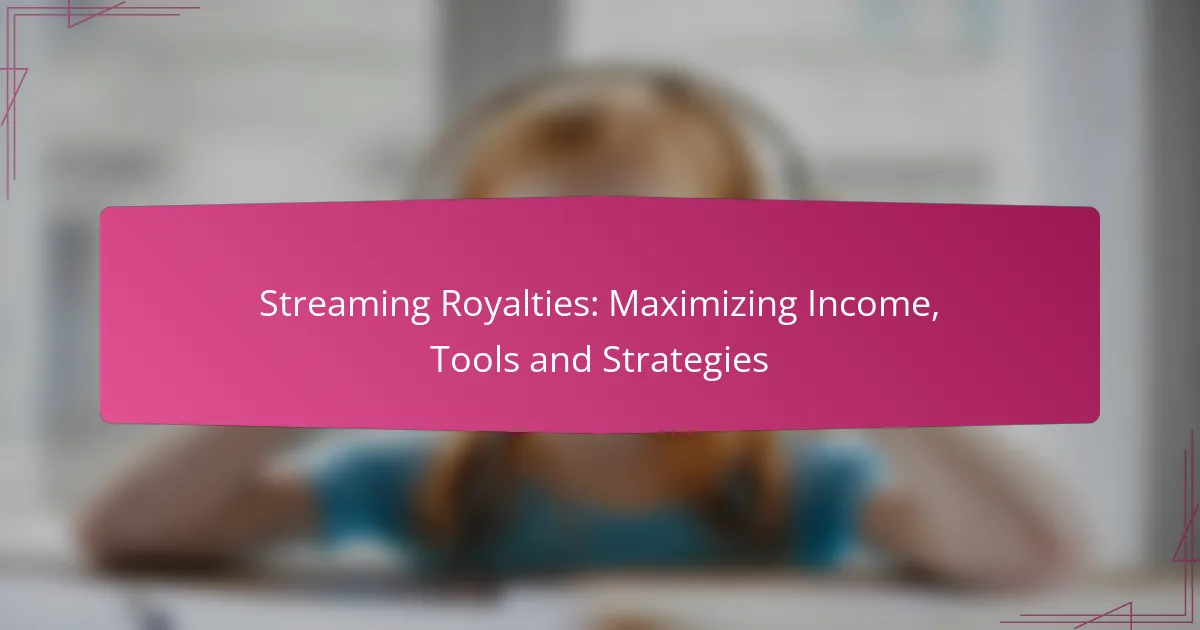Streaming royalties present a valuable opportunity for artists and content creators to generate a consistent income from digital platforms. By understanding revenue models and utilizing specialized tools, creators can effectively track their earnings and optimize their revenue streams. Implementing strategic marketing and collaboration efforts can further enhance visibility and engagement, ultimately boosting streaming income.
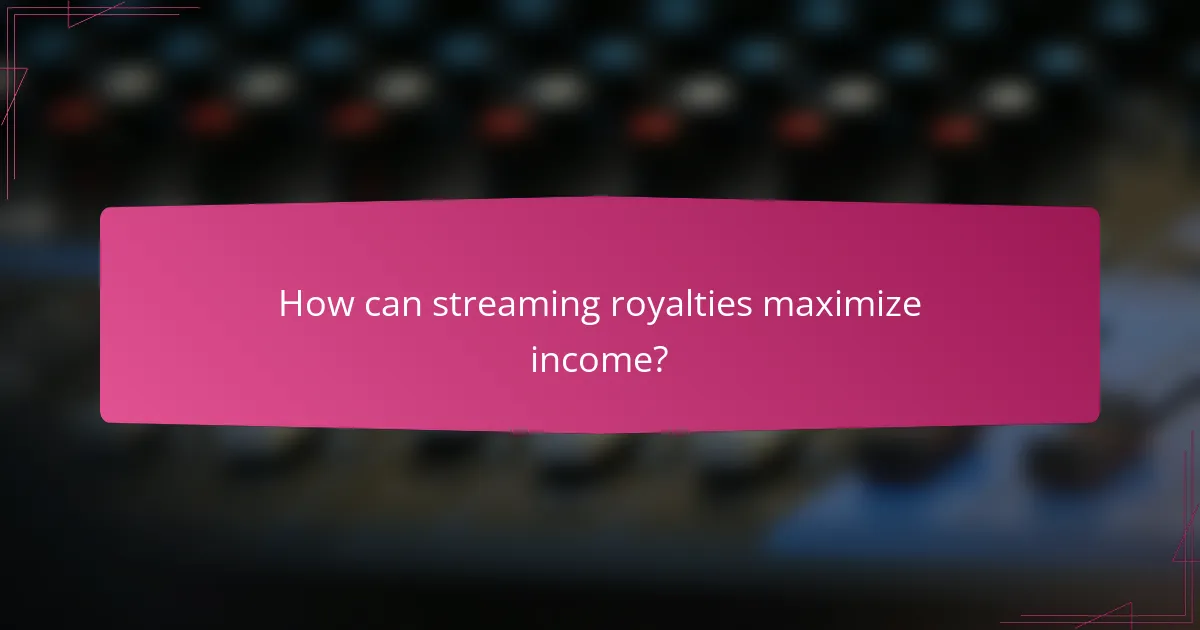
How can streaming royalties maximize income?
Streaming royalties can significantly enhance income for artists and content creators by providing a steady revenue stream from digital platforms. By understanding various revenue models and leveraging available tools, creators can optimize their earnings from streaming services.
Revenue sharing models
Revenue sharing models dictate how income from streaming is divided between platforms and creators. Commonly, platforms like Spotify and Apple Music pay artists a percentage of the revenue generated from subscriptions and advertisements, typically ranging from 60% to 70% for the rights holders.
Understanding these models is crucial for maximizing income. Artists should explore different platforms to find the most favorable terms, as some may offer higher percentages or additional incentives for exclusive content.
Performance rights organizations
Performance rights organizations (PROs) play a vital role in collecting and distributing royalties for public performances of music. Organizations like ASCAP, BMI, and SESAC in the U.S. ensure that artists receive compensation when their music is streamed, played on the radio, or performed live.
Joining a PRO can enhance income by ensuring that all potential royalties are collected. Artists should register their works promptly and keep track of performances to maximize their earnings from these organizations.
Direct licensing agreements
Direct licensing agreements allow artists to negotiate terms directly with streaming platforms or other entities, bypassing intermediaries. This can lead to better financial outcomes, as artists can set their own rates and terms based on their audience and market demand.
When considering direct licensing, artists should be prepared to negotiate effectively and understand the implications of exclusivity or non-exclusivity on their overall income. This approach can be particularly beneficial for independent artists looking to retain more control over their work.
Digital distribution platforms
Digital distribution platforms, such as DistroKid, TuneCore, and CD Baby, facilitate the release of music on streaming services. These platforms typically charge a fee or take a percentage of royalties, but they can simplify the process of getting music onto multiple platforms.
Choosing the right distribution platform is essential for maximizing income. Artists should compare fees, payout structures, and additional services offered, such as marketing tools or analytics, to find the best fit for their needs.

What tools help manage streaming royalties?
To effectively manage streaming royalties, artists and rights holders can utilize various tools designed to track earnings, distribute music, and analyze performance data. These tools streamline the process of monitoring income and maximizing revenue from streaming platforms.
Royalty tracking software
Royalty tracking software helps artists and music professionals monitor their earnings from various streaming services. These tools often provide detailed reports on income sources, enabling users to identify which platforms generate the most revenue.
When selecting royalty tracking software, consider features like real-time reporting, integration with other services, and user-friendly dashboards. Popular options include TuneCore and Songtrust, which cater to different needs and budgets.
Music distribution services
Music distribution services are essential for getting your music onto streaming platforms like Spotify, Apple Music, and Amazon Music. These services not only distribute your tracks but also collect and distribute royalties generated from streams.
Choose a distribution service based on their fee structure, reach, and additional services offered, such as marketing support. Some well-known distributors include DistroKid, CD Baby, and Amuse, each with unique pricing models and features.
Analytics platforms
Analytics platforms provide insights into how your music is performing across different streaming services. They track metrics such as listener demographics, streaming numbers, and geographic data, helping you make informed decisions about marketing and promotion.
Utilize analytics tools like Spotify for Artists or Apple Music for Artists to gain valuable insights into your audience. Regularly reviewing this data can help you tailor your content and marketing strategies to better engage listeners and increase your streaming royalties.
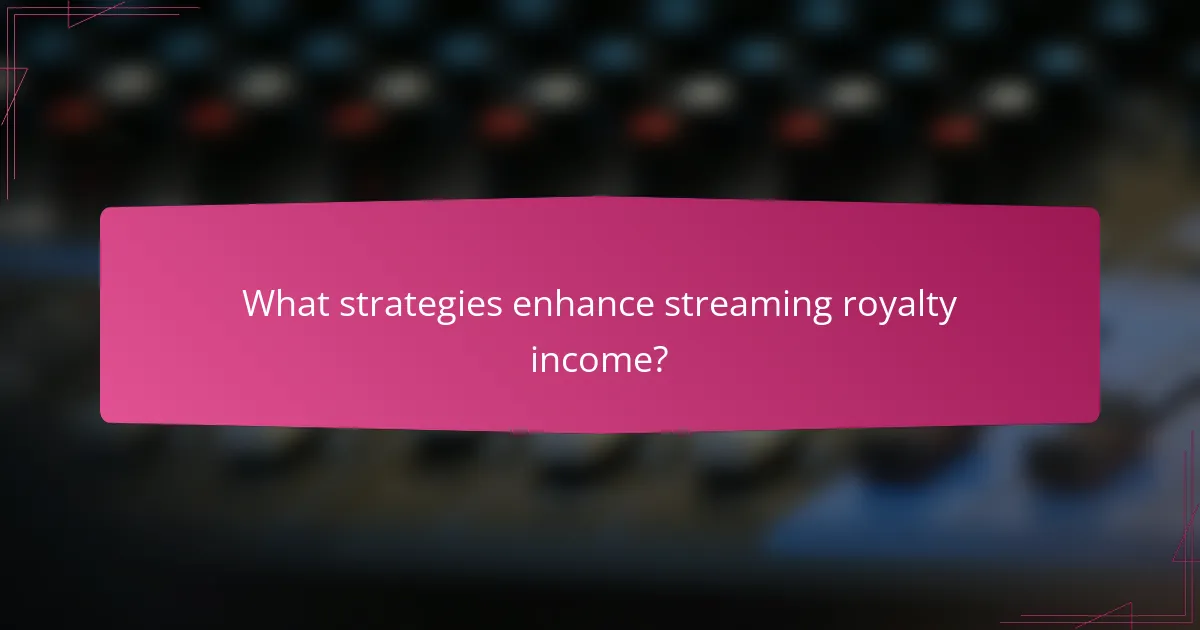
What strategies enhance streaming royalty income?
To enhance streaming royalty income, artists should focus on effective marketing, building a dedicated fanbase, and collaborating with influencers. These strategies can significantly increase visibility and engagement, leading to higher streaming revenues.
Effective marketing techniques
Implementing effective marketing techniques is crucial for maximizing streaming royalties. Utilize social media platforms to promote new releases, share behind-the-scenes content, and engage with fans directly. Consider using targeted ads to reach specific demographics that align with your music style.
Additionally, email marketing can be a powerful tool. Building an email list allows you to inform fans about upcoming releases, concerts, and exclusive content, fostering a stronger connection and encouraging more streams.
Building a fanbase
Building a loyal fanbase is essential for increasing streaming royalty income. Focus on creating authentic connections with listeners through regular interactions on social media and live performances. Engaging with fans can lead to word-of-mouth promotion, which is invaluable for organic growth.
Consider offering exclusive content or experiences, such as early access to new music or special merchandise, to incentivize fans to support your work. This can help transform casual listeners into dedicated supporters who regularly stream your music.
Collaborations with influencers
Collaborating with influencers can significantly boost your visibility and streaming income. Identify influencers within your genre or niche who have a strong following and align with your brand. Partnering with them for promotional campaigns or social media takeovers can introduce your music to new audiences.
Additionally, consider creating content together, such as music videos or live sessions, which can be shared across both your and the influencer’s platforms. This cross-promotion can lead to increased streams and a broader fanbase.
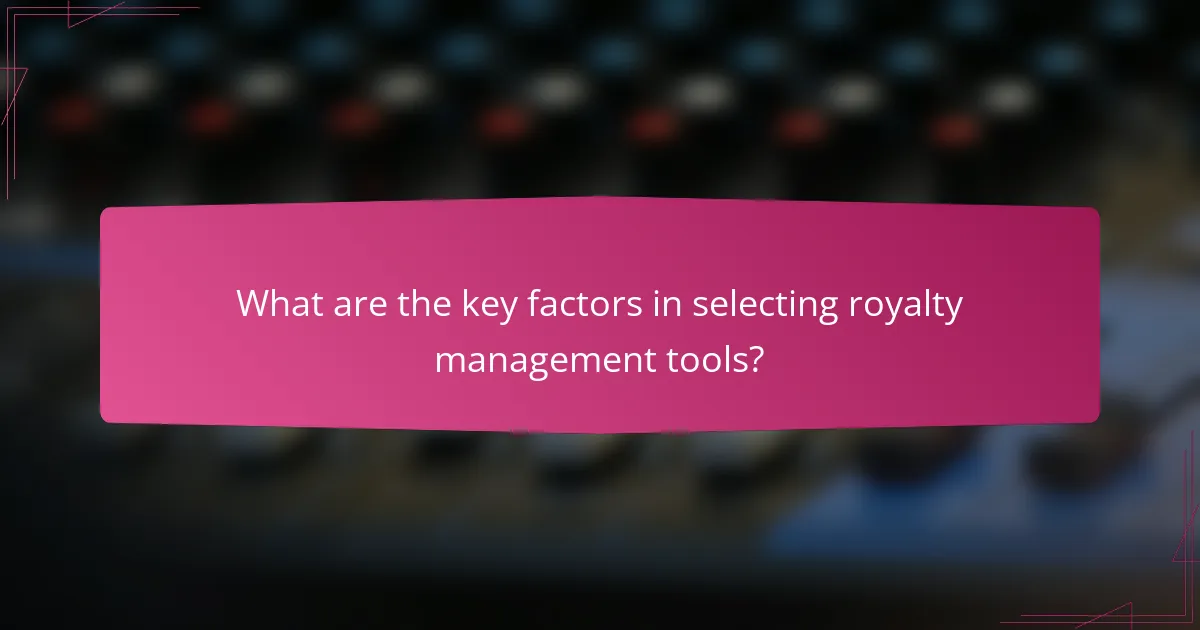
What are the key factors in selecting royalty management tools?
Selecting royalty management tools involves considering factors that directly impact efficiency and profitability. Key aspects include cost-effectiveness, user-friendly interfaces, and integration capabilities with existing systems.
Cost-effectiveness
Cost-effectiveness is crucial when choosing royalty management tools, as it directly affects your bottom line. Look for solutions that offer a good balance between features and pricing, ensuring you don’t overspend on unnecessary functionalities.
Consider subscription models versus one-time purchases. Subscription services may provide ongoing updates and support, while one-time purchases might save money upfront but could incur higher long-term costs if maintenance is needed.
User-friendly interface
A user-friendly interface is essential for maximizing productivity and minimizing training time. Tools that are intuitive and easy to navigate allow users to focus on managing royalties rather than struggling with complex software.
Evaluate the layout and design of the tool through demos or trials. A clean, organized interface can significantly reduce the learning curve and enhance user satisfaction, leading to better overall management of your royalties.
Integration capabilities
Integration capabilities determine how well the royalty management tool works with your existing systems. A tool that seamlessly integrates with accounting, distribution, and content management systems can streamline workflows and reduce data entry errors.
Check for compatibility with popular platforms and APIs. Tools that offer robust integration options can save time and resources, allowing for a more cohesive approach to royalty management.
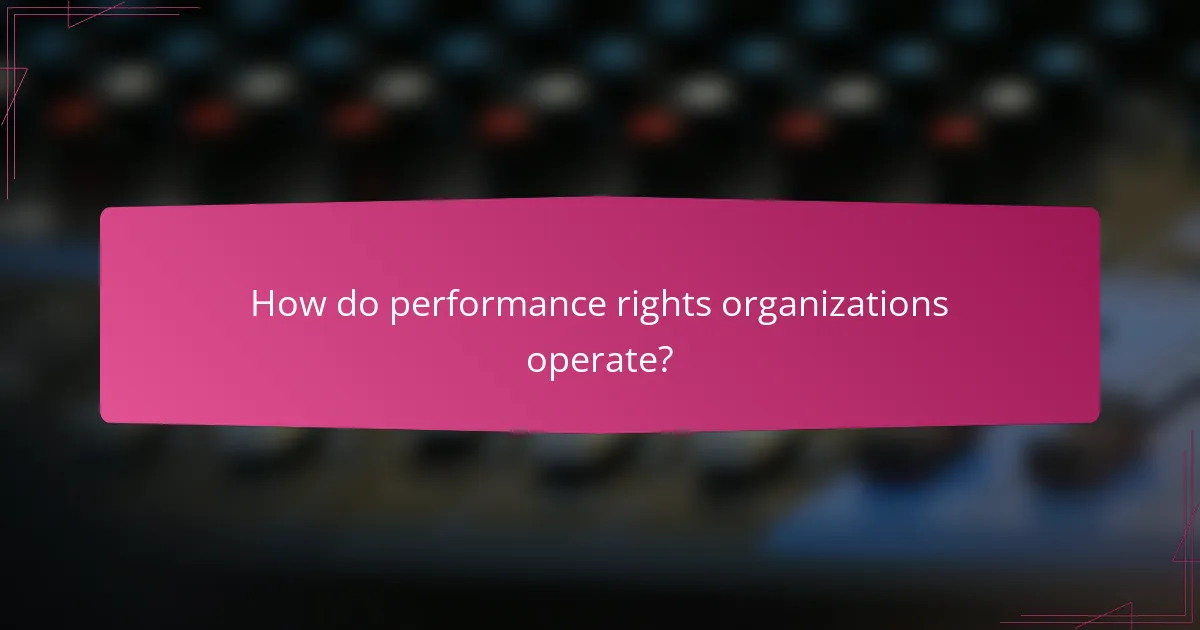
How do performance rights organizations operate?
Performance rights organizations (PROs) manage the rights of artists and songwriters by collecting and distributing royalties for the public performance of their music. They ensure that creators are compensated fairly when their work is played in various venues, including radio, television, and live events.
Collecting royalties
PROs collect royalties through licensing agreements with businesses that use music, such as radio stations, restaurants, and streaming platforms. These organizations monitor performances and track usage through various methods, including digital fingerprinting and surveys. This data helps them determine how much to charge for licenses and how to allocate royalties to their members.
For example, a restaurant playing background music may pay a flat annual fee to a PRO, which then distributes a portion of that fee to the songwriters and performers whose music is played. This system ensures that artists receive compensation based on the frequency and popularity of their work.
Distributing payments
After collecting royalties, PROs distribute payments to their members based on the data gathered about music usage. The distribution process typically occurs quarterly or semi-annually, depending on the organization. Payments are calculated using a formula that considers factors such as the number of performances and the type of usage.
Artists should keep track of their performances and ensure they are registered with the appropriate PRO to receive their share of royalties. Failing to register or report performances can result in missed payments, so staying proactive is essential.
Licensing agreements
Licensing agreements are contracts between PROs and businesses that outline the terms under which music can be used. These agreements specify the types of performances covered, the duration of the license, and the fees involved. They are crucial for ensuring that both the music creators and the businesses using the music are protected legally.
For instance, a streaming service may enter into a licensing agreement with a PRO to stream music on its platform. This agreement allows the service to legally offer a vast library of songs while ensuring that artists receive compensation for their work. Understanding the terms of these agreements can help artists maximize their income from various platforms.
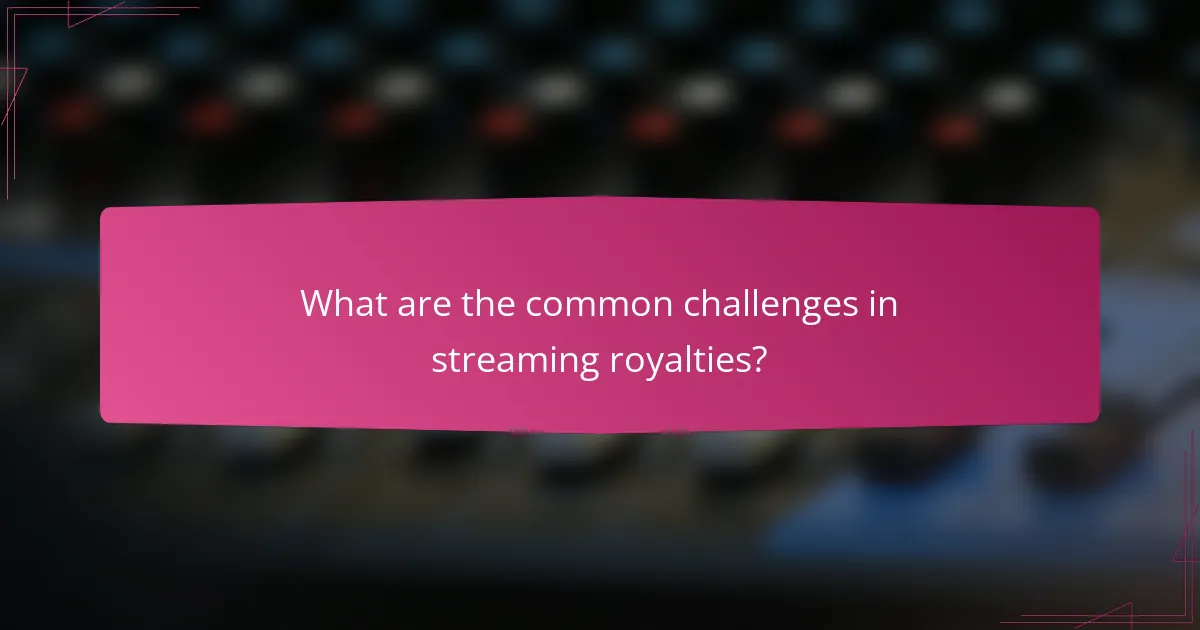
What are the common challenges in streaming royalties?
Streaming royalties present several challenges for artists and rights holders, primarily due to the complexity of rights management and low payout rates from streaming platforms. Understanding these issues is crucial for maximizing income from digital music distribution.
Complexity of rights management
The management of rights in streaming can be intricate, involving multiple stakeholders such as songwriters, producers, and record labels. Each party may hold different rights to a track, complicating the distribution of royalties.
To navigate this complexity, artists should ensure they have a clear understanding of their rights and those of others involved in their music. Utilizing a rights management tool or consulting with a legal expert can help clarify ownership and streamline royalty collection.
Low payout rates
Streaming platforms typically offer low payout rates, often ranging from a fraction of a cent to a few cents per stream. This can make it challenging for artists to earn a sustainable income solely from streaming royalties.
To counteract low payouts, artists should consider diversifying their income streams. This may include live performances, merchandise sales, and licensing music for use in media. Engaging with fans through platforms that offer higher payouts can also enhance overall earnings.
